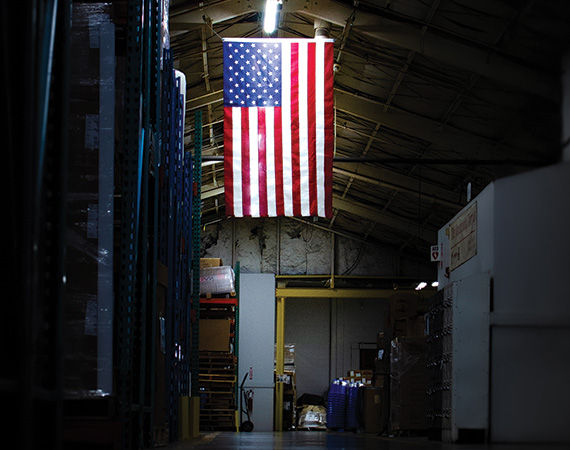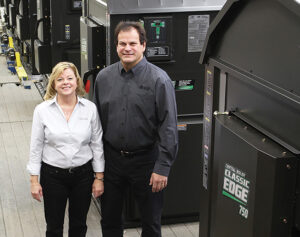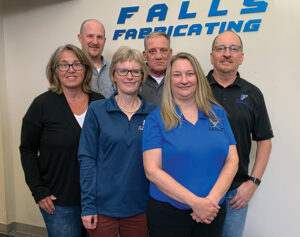The Miller Manufacturing Company campus is a sprawling, 500,000-square-foot facility on the outskirts of Glencoe. With 350 employees, it is the town’s leading employer apart from Green Giant during harvest season. Its inventory includes more than 1,200 items for farm, ranch and pet products, especially for backyard hobbyists in equine, cattle, hog, poultry, pet and even beekeeping.
“I don’t think there’s a farm store anywhere in the United States that we don’t sell to,” says Dan Ferrise, Miller’s CEO.
And not just the United States. Miller’s products are sold in 30 countries around the world.
Miller’s facility has undergone endless expansions. Since 2005, its distribution center staff has grown from 8 to 80; its 30-bay loading dock is a whirlwind of lights and horns, as forklifts buzz between pallets and trailers. Meanwhile at the company’s front desk, you’ll spot local farmers, mud still fresh on their boots, dropping off Hot-Shot and Springer Magrath cattle prods for in-house repairs.
Miller operates on a one-page business plan posted throughout the facility so that everyone at every level knows where the company is headed. Originally packed in a 3-inch binder full of planning documents, Ferrise made it a personal project to reduce the business plan to a single page, something maintained now for at least a decade. It is part of a company culture built around employee involvement. Ferrise says the Miller brands focus on products that satisfy a basic human instinct to nurture and provide.
It’s quite a turn for what began 80 years ago with one man and a chicken fountain.
Unlikely paths
In 1941, inventor and St. Paul native Barney Miller created what he believed was the world’s first automatic poultry water fountain. Connected to a source of fresh water, the Little Giant used gravity and an innovative vacuum design to provide a constant source of water for poultry, meaning one less thing for farmers to worry about. Miller later sold to the Bowell family, who acquired nearby Dassel Metals to produce a new line of galvanized automated nesting boxes that included an automatic egg collection feature aimed at commercial operators. The new owners, however, found greater support with smaller farm and ranch hobbyists, who to this day remain the company’s best customers.
By the time it was acquired by the Frandsen Corporation in 1996, Miller’s properties were spread across four manufacturing sites in two states. In 2005, Miller’s management team had decided to consolidate its far-flung operations under one roof, an abandoned Nordic Track building outside Glencoe. The facility was so large that Miller leased out half of the space. Today, 16 years later — following several expansions — Miller operates the entire campus and owns land nearby, ready to accommodate future growth.
Also in 2005, Miller recruited Ferrise as CEO.
Ferrise remembers the 18-month merger of four facilities into the Glencoe building as both fun and challenging. Miller Manufacturing went through a brief staff reset when nearly all of their 74 employees opted not to move with the business. It was a clean slate, then, but Ferrise knew Miller’s products well and used many of them himself for years. In fact, just last year he harvested 175 pounds of honey from his three beehives.
“You look at every possible way to eat honey,” he says with a smile.
The company rebuilt its staff with other passionate backyard hobbyists like Ferrise, and today that level of product familiarity isn’t uncommon at Miller. It aligns with a customer base that is equally committed to their outdoor pursuits.
“Our customers are very passionate about what they do,” Ferrise says. “They want to take good care of their animals, and from a cause perspective, I think that’s really important.”
American made
Under the Frandsen Corporation’s leadership, Miller used a series of acquisitions to complete its six brand offerings. In total, the company includes: Little Giant, Hot-Shot, Pet Lodge, Springer Magrath, Double-Tuf, and API — producing everything from beehives and honey bottles, feed buckets, and cattle prods to pet transporters and cages, and heated water buckets and hoses. At every step, Ferrise says the company was careful to analyze how the new products might affect its policies and procedures.
“You have to reinvent all of your systems every time,” Ferrise says. “Everything from your ERP (Enterprise Resource Planning) systems, how you release orders to what inventory levels you choose to build and your work instructions and standard work.”
One of those systems included offshoring the manufacturing of many products overseas. Ferrise devoted nearly a decade to flying between the U.S. and Asia to ensure that suppliers in China would not compromise Miller’s high standards of quality.
In late 2019, the company’s cost for offshore manufacturing was rising, and the logistical complexity of container shortages and importing led to a search for alternatives. An analysis by company accountants determined that many of Miller’s plastic injection-molded products could be manufactured competitively here at home, and so the reshoring began.
“It’s just better to have control over your own operation,” Ferrise says. “And once you baked in all of the associated costs, the delta (the difference between total domestic and offshore costs) was getting smaller and smaller all the time.”
Manufacturing in the U.S. would eliminate shipping delays and barriers in language or culture. What’s more, producing from the Miller site in Glencoe or partner locations in Rush City and Anoka meant the company could quickly respond to the demands of sudden growth.
“We made the decision about three months before the pandemic that we were going to bring the business we had spent the last 20 years outsourcing to China back [to the U.S.],” Ferrise recalls. But the company — and the country — couldn’t possibly have known what lay ahead.
Some of the problems were expected, like shortages in shipping containers or raw materials. Others had a more human element, like leaving behind their offshore partners. Miller contacted its Chinese suppliers and requested the plastic injection molds needed for manufacturing be returned to the U.S. Some suppliers, according to Ferrise, responded with concern. It was no secret that the offshore sites had been struggling to maintain a steady supply, but, even as the business transitioned, every effort was taken to maintain good international working relationships.
When those molds returned stateside, they were transferred to Lakeland Tool & Engineering, a 2019 Miller acquisition that began as an injection molder and had the tools needed to do some necessary “tune up” work. Ferrise explains that quality control issues — like excess flashing on the finished plastic products — were a top concern. Where their Chinese team overcame defects through extra labor, Lakeland and its higher average wages needed to ensure its manufacturing would require less human intervention.
Then the pandemic hit. And just as in the Great Recession of 2008, demand for Miller’s products skyrocketed. The pandemic proved to be very good for farm, ranch and pet products.
“People take care of their animals when the economy tanks,” Ferrise says. “With schools shut down,” he adds, “a lot of parents decided to teach their children to raise and care for animals. Specifically, a lot of poultry. That’s exactly what we do.”
Doubling down
As Miller pushed to return manufacturing to the United States, the company recruited Sean Syring as director of marketing. With sales soaring, however, Syring focused his talents toward recruiting and retaining workers.
“I mean, we grew 30-40% in one year,” he says.
Like many firms, Miller offered greater scheduling flexibility, increased wages, and overtime for those employees who appreciate it. Neal Brady, Miller’s general manager and a former high-tech industry veteran, says it’s difficult finding 350 people in an area the size of Glencoe (population 5,500), but Miller has a built-in advantage with its ag-centric mindset of the region. Many take pride in working on products they and their families use themselves.
Miller grew across several categories during the pandemic, rising on average by more than 20%, but poultry products exploded, increasing by more than 40%. Rural, urban, and suburban consumers alike were fascinated by home-raised eggs and the peculiarities of keeping their own chickens. Syring and his team produced educational YouTube videos and social media content for new poultry owners on topics like incubation, housing, and general care. Their engagement numbers boomed, with thousands of inexperienced keepers seeking guidance.
Meanwhile in the Miller warehouse, inventory levels dropped with the rush of new customers, and the company’s policy of maintaining a 30- to 90-day stockpile was being tested. New hires were a precious commodity, so the crew doubled down.
“As we ramped up, the folks here really rallied to the challenge. A lot of places were closing, a lot of people were out of their jobs; there was a lot of uncertainty,” Brady remembers. “We flipped a switch the other direction, and it was instantaneous that our sales were going through the roof. We needed a lot more people than we were ever going to get, so we started running overtime, we started running weekends, we were going around the clock. There was a good rally that happened from people’s own realization as to what was going on and then appreciation for what they were manufacturing.”
Inventory levels would slowly recover, which Brady attributes to the team’s hard work and dedication to the customers they serve. And while product sales were strong, Syring saw the perfect opportunity to highlight the return to American manufacturing.
Miller pushed forward with its reshoring efforts, and the company launched a “Buy American” campaign last fall through its website, retail partners, and social media. The company used a sweepstakes program with prize packages themed around different farm, ranch, and pet hobbies and a final $2,500 shopping spree as a way to gauge consumer interest and raise awareness for its American-made products. Customers were asked to register on the company website, and three winners were chosen each month from October to January, before being entered into the grand-prize drawing. More than 50,000 customers responded, and Syring says the data Miller received paints a clear picture: While some shop on price, many of Miller’s backyard hobbyists put value in supporting American products. Miller’s retail store partners created custom product displays around the sweepstakes, and some have become permanent fixtures.
“A lot of them are leaving their displays up, and they’ll rotate what they know are U.S.-made products from Miller. So, when consumers come in they know they’re getting U.S. made,” Syring says.
In the customer service department, the team receives phone calls weekly praising the return to American manufacturing, with the only call to action being demand for more. Meanwhile, workforce morale is buoyed by the pride taken in Miller’s commitment to in-house and in-country production. Ferrise notes that the bump in morale also aids an increase in retention.
Elsewhere, Miller is fine tuning for e-commerce — a growing trend for their partners. While Ferrise is clear that Miller has no intention of entering direct sales, ensuring packaging meets standards such as Amazon’s “Frustration-Free Packaging” certifications — which are designed to minimize waste and non-recyclable materials — is a value add for their online retailers. Ferrise also keeps a list of prospective acquisitions and foresees one or two in the next two years. Plus, the company is beta testing 12 different automation programs to offset the 60-70 employee deficit it regularly experiences.
“We’ve really started to focus on our automation initiative,” Ferrise says, “and I think that’s going to be an important piece of our future.”
Syring calls last year’s “Buy American” promotion a great first start, and the 2021 Miller Manufacturing catalog wears the new branding with pride, with special labels to highlight products either made or assembled in the U.S.A. As the company’s selection of American-made products grows, Miller Manufacturing is challenging a decades-old notion that domestic labor can’t compete on overall value. The company is pushing for more American manufacturing with fewer nagging qualifications, like country of materials origin or country of assembly. And Ferrise says they won’t be letting up any time soon, either.
…
Featured story in the Fall 2021 issue of Enterprise Minnesota magazine.


